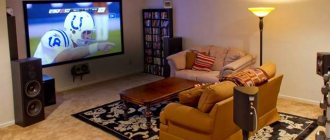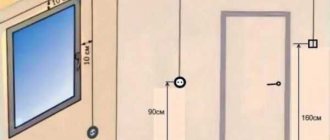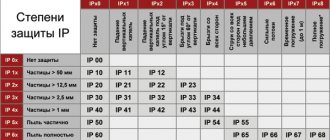Artificial lighting is the most important component of comfort. This is a necessary minimum, without which modern man cannot imagine his existence. It is clear that artificial light sources need to be controlled. Lighting control involves three functions:
- inclusion
- shutdown
- brightness control (dimming)
There are many devices to control lighting. In this article we will talk about the most common and necessary ones - switches and switches. But first, a little clarification: we are talking about electrical installation equipment for household use for hidden and open installation, designed to work in alternating current networks and designed for a voltage of 220-230V. These are the devices that are used in everyday life. They are also used in office and administrative buildings.
Buy switches, switches, open the product catalog.
Keyboards
The most common type of switches. The electrical circuit is closed and opened when the key is switched from one position to another. One-, two- and three-key versions are available.
Key switches are inexpensive, convenient to use and easy to repair. On the other hand, they have a rather low operating life, the lighting intensity cannot be adjusted, and there is no energy saving mode.
Push-button
The principle of operation of a push-button switch is similar to a key switch: you press the button - it locks and closes the contact. Pressing it again opens the contact. Often available with LED backlighting. Such switches should not be confused with ordinary electrical buttons, for example, on a bell: such buttons make a contact only if they are held by hand.
Push-button switches will easily fit into the interior of any room, despite their slightly non-standard appearance. They cost a little more than their keyboard counterparts. But they will serve you faithfully for a long time.
Terminals for connecting wires
There are two main types of terminals for connecting conductors to a switching device:
- screw - the conductor core is clamped by tightening the screws;
- clamping (spring) - just insert the conductor, the spring-loaded platform will press it itself.
Spring terminals are more convenient and installation is faster. But screw ones are considered more reliable.
Device with spring terminals.
On the other hand, if the wiring is done with a cable with aluminum cores, you should remember the ductility of this metal. Screw terminals require periodic tightening, otherwise bad contacts and the corresponding consequences cannot be avoided. The spring ones will press the wire themselves.
Dimmers (switches with regulator)
They are a kind of rheostat, which is familiar to most of us from school physics lessons. A dimmer works on the same principle. A rheostat changes the resistance of an electrical circuit, and therefore the current strength in it. Higher resistance means lower current. The lower the current, the dimmer the light bulb included in the electrical circuit burns. With the help of such switches, you can adjust the lighting intensity by turning the control wheel.
The advantage of dimmers is energy savings (some devices even turn off on their own when no one is in the room) and ease of use. But there is also a minus: due to the high cost, not everyone can afford such switches. Note: dimmers work great with incandescent lamps, but with recently fashionable LED lamps and lamps they can conflict and function incorrectly.
Switch-button 250V 2A (2s) ON-OFF white (for table lamp) REXANT
0)window.scrollBy(0,-100);">
| 1. | Yuri Kozlov, 08/20/2021 10:45 Good afternoon, Yuri. The manufacturer does not provide such information. If the installed module in an LED lamp fails, you will need to replace the lamp under warranty or buy a new one. Good afternoon, Mikhail. Levit series is two-color. The main color of this dimmer is anthracite. At the very bottom of the rotary knob there is a smoky black stripe. Good afternoon, Dmitry. This is a transmitter for the “Cozy Home” radio control system. Powered by battery (included). The receiver must be purchased separately, for example: SQ1508-0209, SQ1508-0211, SQ1508-0212, SQ1508-0213. Good afternoon, Vladimir Nikolaevich. T100 - T160 lamps are not suitable for this lamp. Good afternoon, Pavel. This lamp is suitable for an 11W lamp. 9W lamp is not recommended. Good afternoon, Peter. Material of manufacture: nickel-plated brass. Good day, Andrey. Shaft length - 60 mm, shaft diameter - 28 mm. Good afternoon, Alexander. Production - October 2021 Good afternoon, Radik. The frequency and location of lamps can be suggested by the design organization to create comfortable lighting for the room. When installing a BAP into a lamp, it can become an emergency. Good day, Andrey. UK600 cabinets can be connected to each other horizontally and vertically. The connecting element not only provides the possibility of laying cables, but also guarantees even gaps between the door frames of the connected cabinets. For this, an accessory with article number 2CPX031408R9999 is used. Good day, Andrey. Place an order through the website's shopping cart at a physical address. or legal face. Good afternoon, Marina. It is possible to find lamps for this lamp, but our assortment only includes components for it. Electronic ballasts and components for its connection: Choke Vossloh Schwabe L5/7/9/11.307 230V/50HZ for CFL lamps - Article number: 163694 Cartridge 35007 VS G23 M3 central, M4 side and for self-tapping screws - Article number: 101310 Installation wire PV-1 (PuV ) 1.0 white GOST 31947 (PV1) - Article: M0001132 Good day, Sergey. Replacement dies for crimping pliers KO-5E are not supplied. Good afternoon, Alexander. The Osram 4ArXS HSD lamp for photo-optics can be used in various lighting devices with their own requirements for ballasts and ignition units. Such information can be found in the device passport. We don't have such information. Good afternoon, Alexey. We can offer you from stock: LED transformer BLV Trafo Luxia 0-105W 230-12V for LED lamps - Article: 456002 Good afternoon, Igor. An LED lamp is used. Good day, Sergey. Yes. Maybe. Good afternoon, Alexey. Yes, the cable is sold in multiples of 1 meter. Good afternoon, Irina. Yes. This electronic ballast will work with 2 18W lamps. Good day, Andrey. The socket in the lamp is 16A 220-240V. Good afternoon, Roman. Cable socket ABB 3125 C6W IP67 125A 3P+E with article number 2CMA166924R1000. Good day, Sergey. The operating manual indicates a calibration interval of 5 years. Manufacturer IEC. Good afternoon, Olga. Yes. This light is designed for T5 6W G5 212mm lamp. A T5 6W 2700K lamp is included with the luminaire (you will need to remove it). You may need to purchase another power cable for the lamp: Network cable with plug 1.1 m (cable 1100mm) - Article: 666521 By submitting data, you agree to the privacy policy. 0)window.scrollBy(0,-100);"> |
By submitting data, you agree to the privacy policy. By submitting data, you agree to the privacy policy.
— There is no minimum order amount.
— Nizhny Novgorod, st. Beketova, 73A
- cash upon receipt. — by bank card through the terminal. — bank transfer according to the issued invoice (payment is credited within 24 hours)
Delivery in Nizhny Novgorod
— 190 rubles (order amount up to 5,000 rubles). — 0 rubles (order amount more than 5,000 rubles) — from 10.00 to 18.00 on working days in the Russian Federation.
- cash upon receipt. — bank transfer according to the issued invoice (payment is credited within 24 hours)
Delivery in the Nizhny Novgorod region
— The minimum order amount is 1000 rubles. — from 500 rubles (order amount up to 10,000 rubles). - FOR FREE
(order amount more than 10,000 rubles). — from 10.00 to 18.00 on working days in the Russian Federation.
- cash upon receipt. — bank transfer according to the issued invoice (payment is credited within 24 hours)
Ways to receive orders
— There is no minimum order amount. — Moscow, Novokhokhlovskaya str., 91, building 10. — from 10.00 to 20.00 on working days in the Russian Federation. — the order is paid upon receipt.
— The minimum order amount is 1000 rubles. — 300 rubles within the Moscow Ring Road. — from 10.00 to 18.00 on working days in the Russian Federation. — the order is paid upon receipt.
- Delivery in the Moscow region - more details.
— The minimum order amount is 1000 rubles. — 500 rubles up to 5 km. from MKAD. — 40 rubles per 1 km. from the Moscow Ring Road + 300 rubles within the Moscow Ring Road, depending on the order amount. — from 10.00 to 18.00 on working days in the Russian Federation. — the order is paid upon receipt.
- Delivery to cities of the Moscow region by Courier Service - more details.
— The minimum order amount is 1000 rubles. — Delivery to the Courier Service terminal in Moscow — Free. — All courier services are paid by the buyer. — Prepayment of the order, payment for Courier Service upon receipt.
- Sending to Russian cities by Courier Service - more details.
— The minimum order amount is 1000 rubles. — Delivery to the Courier Service terminal in Moscow — Free. — All courier services are paid by the buyer. — Prepayment of the order, payment for Courier Service upon receipt.
- Sending to cities of the Russian Federation by Transport Company - more details.
— The minimum order amount is 1000 rubles. — 300 rubles delivery to the Transport Company terminal in Moscow. — All services of the Transport Company are paid by the buyer. — Prepayment of the order, payment for the services of the Transport Company upon receipt.
Ways to receive orders
— There is no minimum order amount. — Moscow, Novokhokhlovskaya str., 91, building 10. — from 10.00 to 20.00 on working days in the Russian Federation.
Payment:
- cash upon receipt. — by bank card through the terminal. — bank transfer according to the invoice (receipt occurs within 24 hours)
— The minimum order amount is 1000 rubles. — 300 rubles within the Moscow Ring Road. — from 10.00 to 18.00 on working days in the Russian Federation.
Payment:
- cash upon receipt. — bank transfer according to the invoice (receipt occurs within 24 hours)
- Delivery in the Moscow region - more details.
— The minimum order amount is 1000 rubles. — 500 rubles up to 5 km. from MKAD. — 40 rubles per 1 km. from the Moscow Ring Road + 300 rubles within the Moscow Ring Road, depending on the order amount. — from 10.00 to 18.00 on working days in the Russian Federation.
Rotary
About 50 - 60 years ago, rotary switches were still actively used in the construction of houses, but recently they have been used only in “antique” design projects or in creating interiors in country, loft, and Provence styles. As a rule, they are produced only for outdoor installation and are used in conjunction with open wiring. Switched by turning the lever 90°.
Legrand sockets
The "legrand" sockets shown in the photo have clamp terminals. On the packaging there is an inscription: “design and quality of solutions”, “aesthetics of solutions” and “new generation sockets”. All this is a lie.
The plant depicted on the packaging symbolizes the design engineers' rejection of traditional tobacco smoking and their preference for more inspiring mixtures.
I said a lot of bad words while installing these “ sockets ”. I will not quote these words here; you all know them well. The terminals allow the wire to pass inside them well and securely fix them, but they will never release them back. Leading designers, focusing on the new generation, made terminals according to the drawings of bear traps from the beginning of the last century. This interesting engineering solution forced me to completely disassemble the socket to remove the wire, which added several abrasions to my fingers.
Previously, I considered the champions in the inconvenience of existing sockets to be construction kits whose terminals fell apart during assembly. But legrand specialists greatly improved these indicators of “handedness” in many respects and came out on top.
Rope
The operating principle of this switch is similar to a push-button switch: by pulling the string until it clicks, you close the contacts. Pull a second time and open. This type of switch is primarily used in wall sconces and sometimes for turning on exhaust fans.
Rope switches are not only used for decorative purposes; they have a number of practical advantages. For example, a dangling cord is easy to find by touch in the dark, and such switches are also suitable for families with small children; the child can easily reach it and be able to turn the light on and off independently.
Acoustic
Such switches are also called clap or sound switches. Turning on occurs by giving a sound signal of a certain volume, for example, clapping your hands. Switches of this type with a timer are installed not only in apartments, but also on staircases. Some models provide a time setting after which the switch disconnects the circuit. Often, acoustic switches are hidden in distribution boxes and are duplicated by regular keyboards.
The main advantage of this model is obvious: with it you don’t have to feel for the switch in the dark or walk across the entire apartment in dirty shoes because you forgot to turn off the lights. However, such devices do not always respond the first time and can operate spontaneously, which sometimes irritates owners.
Remote
These are switches that are activated by a signal from the remote control. There are also combined models: for example, a touch switch with a remote control. Remote switches are not very common because they are quite expensive. In addition, remote controls tend to get lost.
But there are also advantages. Firstly, with remote switches you don’t have to damage the walls: you just need to arm yourself with self-tapping screws or double-sided tape and secure the switches in the right places. And no problems with fixed wiring. Secondly, you can turn light bulbs on and off from anywhere in your apartment or house and feel like the master of light.
Switches.
Switches are designed to control lighting from several places. There are two types of switches: regular switches, for controlling lighting from two places. And cross switches for control from three places or more.
In any, even small apartment, situations often arise when the ability to control light from several places is necessary for basic comfort.
Situation 1. You come home. There is a switch next to the front door. You turn on the light, take off your outdoor shoes. Move on and take off your street clothes. You don't need any more light in the hallway. But, in order to turn it off, you will have to go back to the front door, and then walk back along the dark hallway (or corridor). Agree this is inconvenient.
Situation 2. The apartment has an L-shaped corridor. To get from the “far” room to the kitchen (to the bathroom) or back, you are forced to walk through the entire corridor. If you are careful and live alone, after a while you will not feel any discomfort. If you have less than tidy household members, then every passage along an unlit corridor turns into an exciting, but unsafe quest. After all, unexpected obstacles may await you along the way: shoes, scarves, hats, backpacks lying in the aisle. If you have children, then also toys. By the way, about children: while the child is small, you will have to make this journey with him in your arms... The quest is getting more complicated, isn't it?:
Situation 3. In the bedroom, the switch for the overhead (general) lighting is located next to the door. It is important to provide the ability to control this light without getting out of bed. One option is to plan ahead to install the switches. Recently, more and more often they are trying to introduce elements of the “smart home” system into apartments. In particular, in this situation, many people find it convenient to use remote-controlled switches instead of switches. In theory, this is convenient. In practice, remote controls get lost and break. In the dark it takes a long and tedious search for it. The batteries in the remote control need to be changed periodically. And remote control switches break down much more often than conventional mechanical switches and switches. In general, all other things being equal, switches are more convenient. Another option: turn on/off the light using a smartphone. The same story as with the remote control, only the smartphone also “freezes” from time to time.
However, one can argue with all these arguments. With all but one thing: speed. All this (remotes, smartphones) takes longer and is more difficult than clicking a key. Well, if you really want a “smart home”, then no one is stopping you from subsequently replacing the regular switch with a remote-controlled switch. The wiring is already there...
To control the lighting from two places, two switches are used. The schematic diagram for connecting switches for control from two places looks like this:
Three-position control requires two switches and one cross-switch. Lighting control from three places, circuit diagram:
To control from four places, two cross switches are required, and so on. Each cross switch adds another lighting control location. However, if you need to control the light from more than three places, it makes sense to purchase a bistable relay and ordinary push-button switches (buttons). With a large number of control points, this option will save on both mechanisms and wires.
Read more about lighting control using relays here:
Switches, type of control.
Switches, like regular switches, may differ in the type of manipulator. This could be a key, touchpad, rotary knob, or lever. There is no point in dwelling on this in detail, because... From the front side, the switches look the same as switches.
Switches, number of keys
Switches can be single-key or two-key. Two-key switches are used to independently control two lighting groups. The wiring diagram using two-key switches looks like this:
Cross switches can only be single-key. There are no two-key crossover switches. There is only one series where such a device can be assembled - the Zenit series (ABB). Read more about Zenit two-key cross switches here:
Zenit two-key cross switch
Switches, rated current.
The switch contacts are designed to switch a load of a certain power. It is prohibited to connect a large load to the contacts. Typically, switch contacts are rated for 10A current. That is, at a voltage of 220V, the load power should be no more than 2.2 kW (for incandescent lamps).
Select switches/switch, algorithm:
- Switch or switch.
- Built-in or surface mounted
- Number of poles
- Number of keys
- With or without backlight
- Control or orientation lighting
- Series and control method
Tell friends:
Passing
Externally, a pass-through switch is no different from an ordinary one, but its internal filling has a slightly different layout. Pass-through switches allow you to control one electrical appliance (or a group of electrical appliances) from different points in space.
For example, you have a two-story house. You approach the stairs and turn on the lamp that illuminates it with the switch located below, on the first floor. You go up to the second floor. Light on the stairs is no longer needed. If there was a regular switch downstairs, you would either have to leave the light on the stairs on or go down to turn it off. This is exactly the problem that pass-through switches solve: you place them on top and bottom and control one lamp from different points.
Unfortunately, in order to fit such convenient pass-through switches into the lighting system of your home or apartment, you will have to spend a lot of money and effort (compared to classic options) due to the complex wiring diagram, the impressive amount of materials used and the high cost of the mechanisms themselves.
Housing protection degree
Household switches are used in various conditions, so their housings can be made in different protection levels. There is a GOST that regulates this degree.
In electrical engineering, the IP marking system has been adopted, characterizing the protection of the housing from the ingress of water and solid particles to current-carrying elements. It is applied to the switch and indicated in the accompanying documentation.
All electrical installation devices have a certain degree of protection from dust and water. There is an international marking that clearly shows this degree. It can be applied directly to the body of the product
The marking itself is an alphanumeric record. The letters IP are applied first, indicating the type of marking. Next is a number that indicates the degree of protection against pollution.
The lowest is indicated by a zero, the highest by a six. Devices from the “zero” group do not have any protection against dust; devices with the number 6 on the body are completely protected from it. They work great even in rooms where there is a high level of dust.
The second digit of the marking indicates the current level of protection against moisture. There are numbers from zero to nine. The first group of switches is equipped with a housing that lacks moisture protection. The latter indicates the highest degree of protection.
Such devices can function normally if completely immersed in water, including hot water. After these two numbers there may also be letters that provide additional information. But they are practically not used for switches.
Taking into account this marking, you should choose switches for non-residential and residential rooms with different purposes. For example, for bedrooms and living rooms, IP20 housing protection will be sufficient; in damp rooms and bathrooms, devices with IP44, or higher, should be installed.
For saunas, baths or showers, devices with IP54 are suitable. Similar ones are installed on the streets, in unheated and dusty rooms. In the latter case, the degree of protection may be higher.











